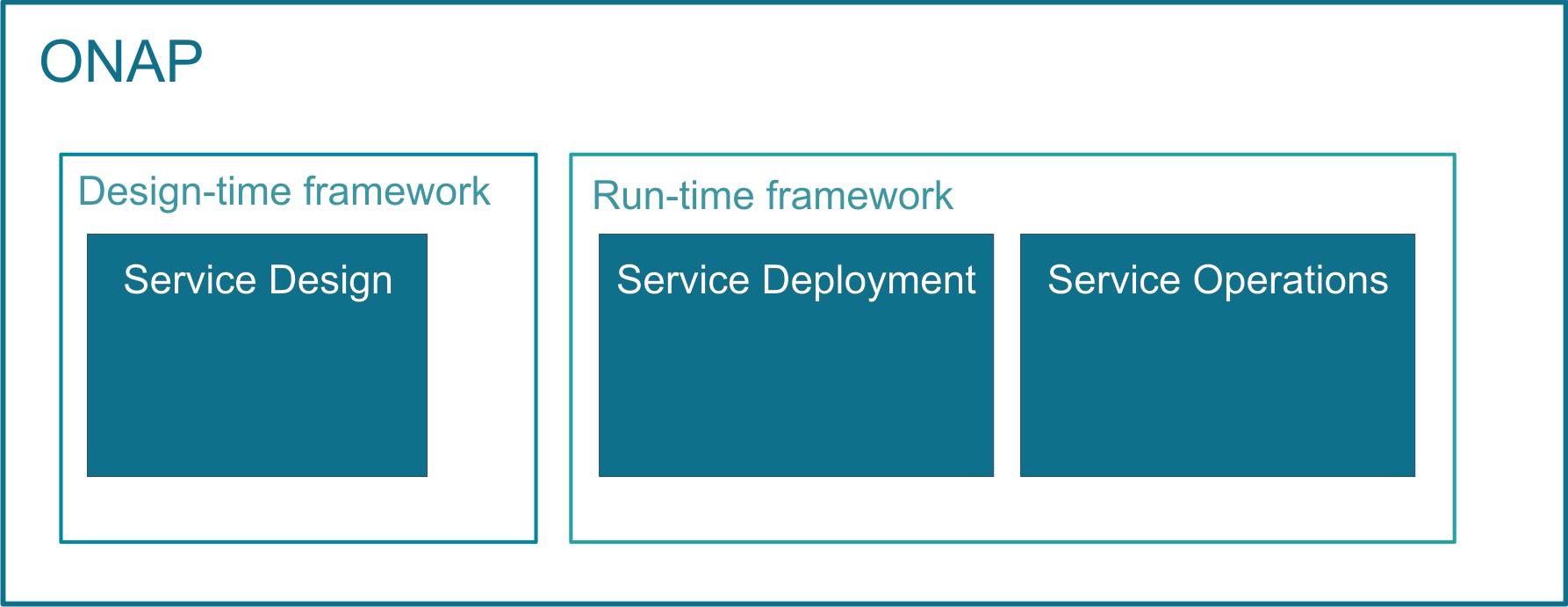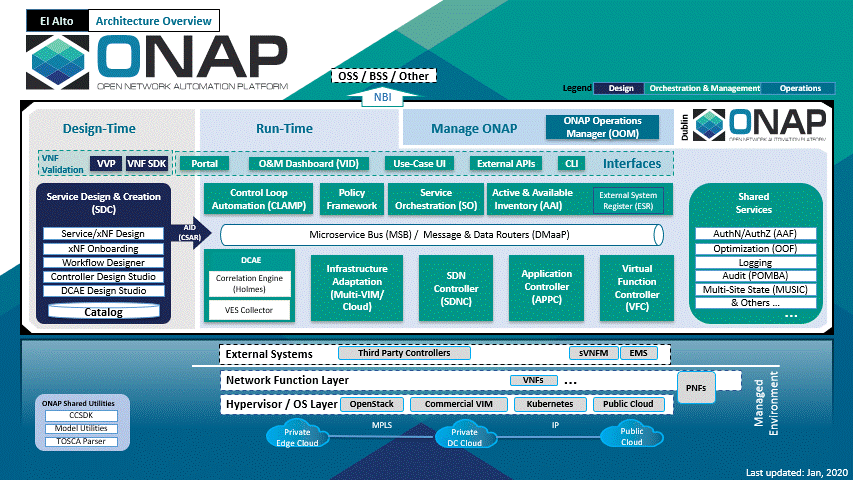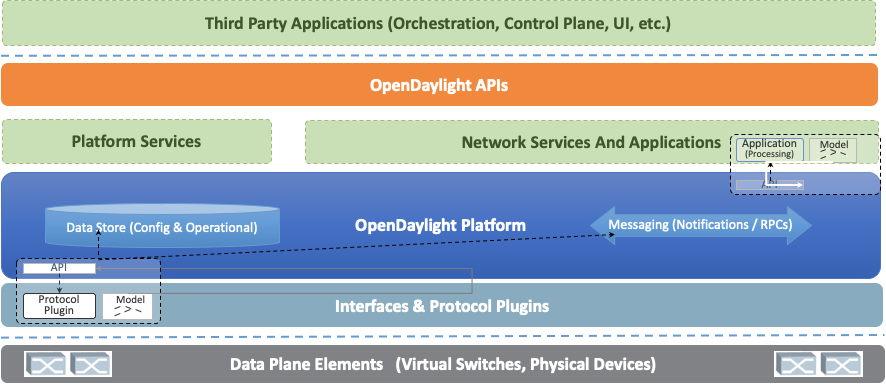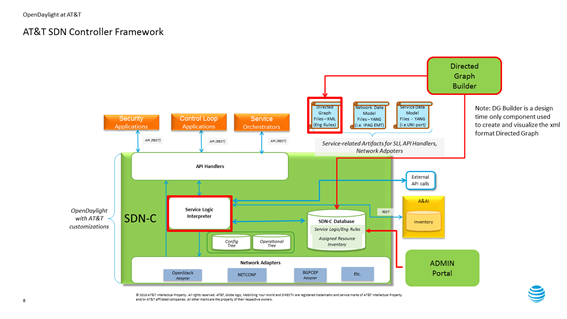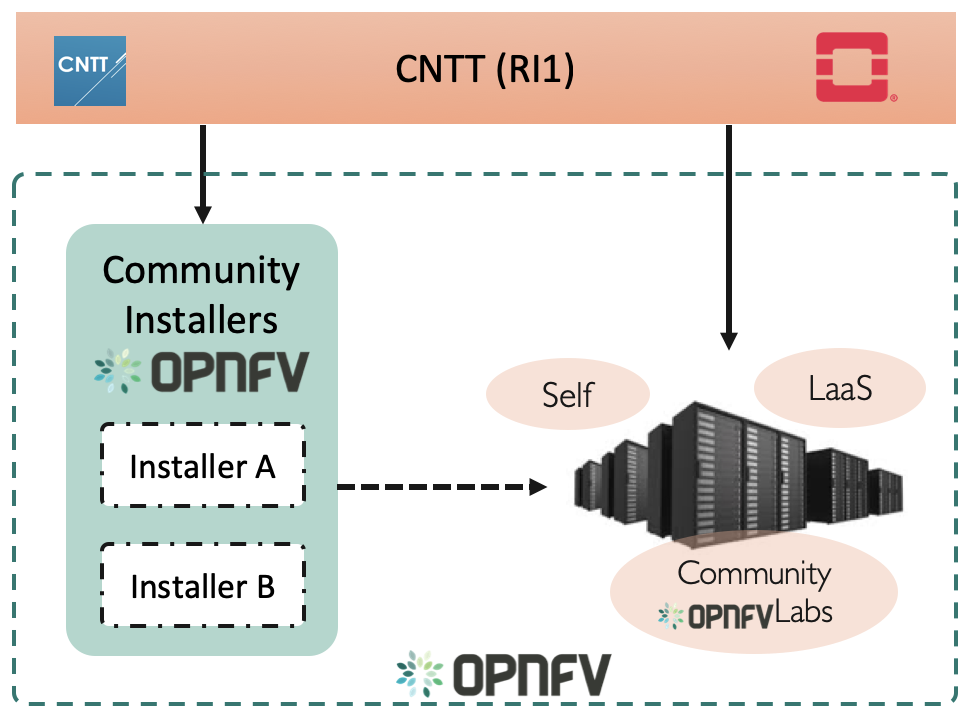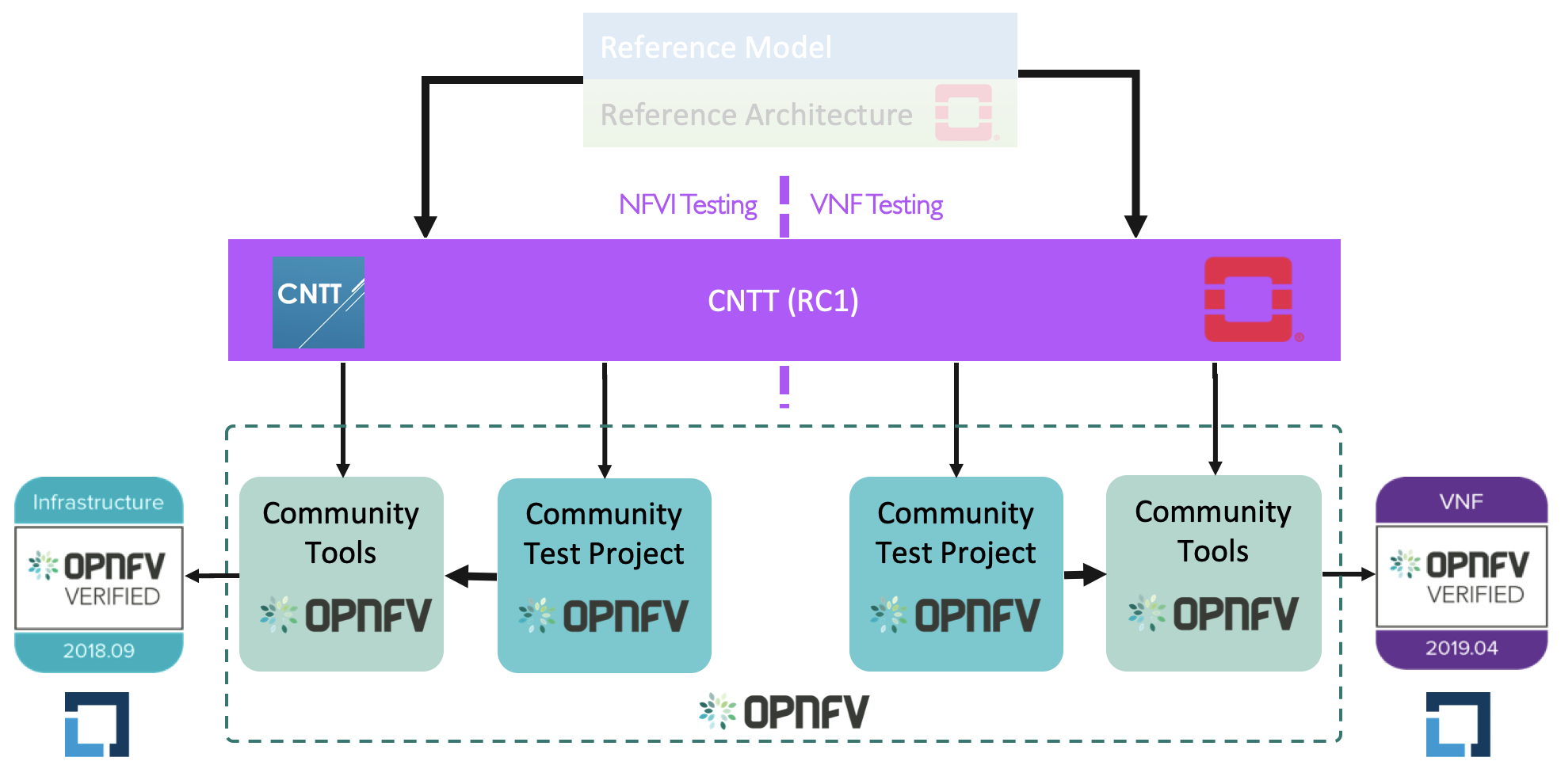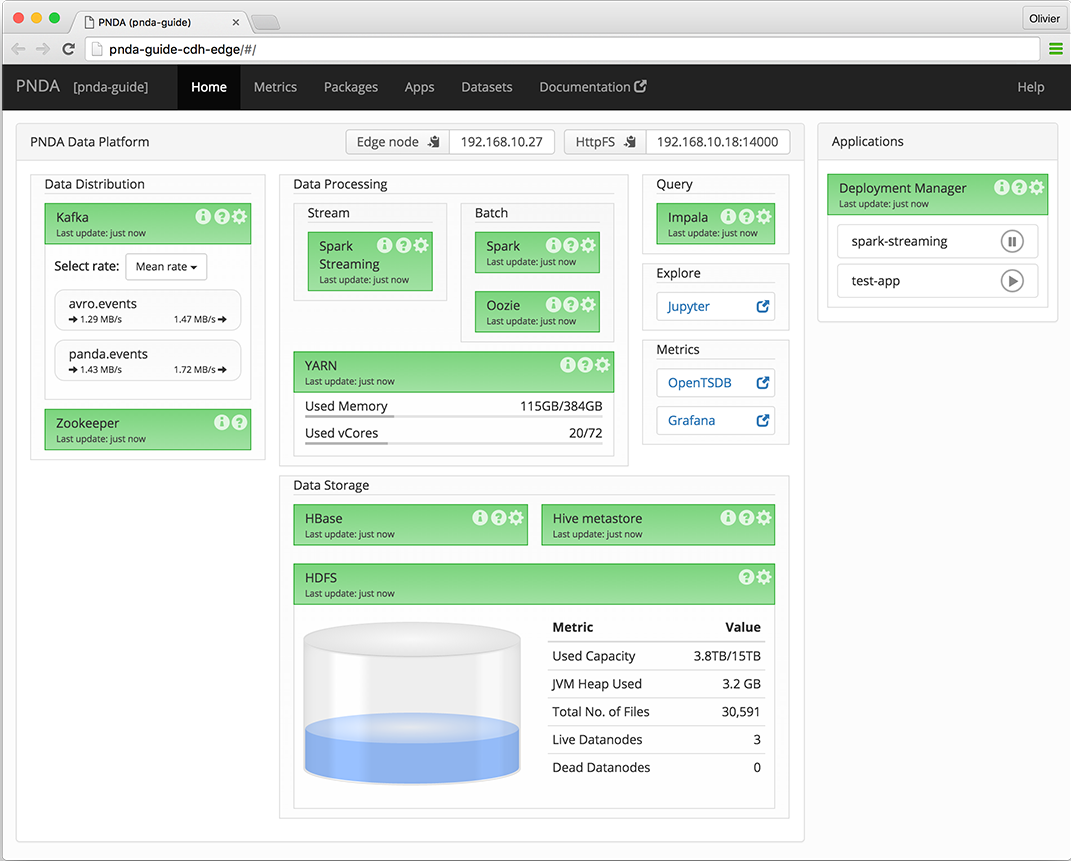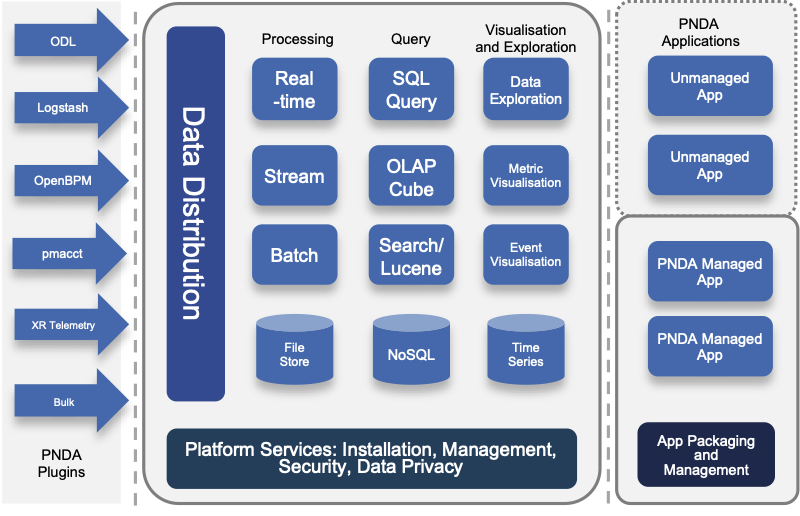...
| Table of Contents | ||||
|---|---|---|---|---|
|
Notes to section editors:
- Describe goals, technologies, key features, etc.
- This chapter does not replace your project specific technical documentation
- You may include a reference to your community wiki space.
- Try to avoid references to specific time-dependent aspects of your project that might render this whitepaper obsolete quickly.
- Please keep the length of your section to 1-2 pages.
3.1 FD.IO
Editor: John DeNisco
(DRAFT)
FD.io (FD.io (Fast data – Input/Output) is a collection of several projects that support flexible, programmable packet processing services on a generic hardware platform. FD.io offers a landing site with multiple projects fostering innovations in software-based packet processing towards the creation of high-throughput, low-latency and resource-efficient IO services suitable to many architectures (x86, ARM, and PowerPC) and deployment environments (bare metal, VM, container).
...
FD.io VPP supports and has tested most DPDK drivers (some have not been completely tested). FD.io VPP also has some native drivers most notablly VMXNET3 (ESXI), AVF (Intel), vhostuser (QEMU), virtue, tapv2, host-interface and Mellanox.
Use Cases
Routers,
...
Universal CPE etc.
Broadband Network Gateway
Load Balancer
Intrusion Prevention
Continuous System Integration and Testing (CSIT)
The Continuous System Integration and Testing (CSIT) project provides functional and performance testing for FD.io VPP . This testing is focused on functional and performance regressions.
Hybrid Information-Centric Networking (hiCN)
Hybrid Information-Centric Networking (hICN) is a network architecture that makes use of IPv6 or IPv4 to realize location-independent communications. A scalable stack is available based on VPP and a client stack is provided to support any mobile and desktop operating system.
Other FD.io Projects?
3.2 ONAP
Editor: Chaker Al-Hakim
Introduction to ONAP
The Open Network Automation Platform (ONAP) project addresses the rising need for a common automation platform for telecommunication, cable, and cloud service providers—and their solution providers— that enables the automation of different lifecycle processes, to deliver differentiated network services on demand, profitably and competitively, while leveraging existing investments.
Prior to ONAP, telecommunication network operators had to keep up with the scale and cost of manual changes required to implement new service offerings, from installing new data center equipment to, in some cases, upgrading customer equipment on-premises. Many operators are seeking to exploit Software Defined Network (SDN) and Network Function Virtualization (NFV) to improve service velocity, simplify equipment interoperability and integration, and reduce overall CapEx and OpEx costs. In addition, the current, highly fragmented management landscape makes it difficult to monitor and guarantee service-level agreements (SLAs).
ONAP is addressing these challenges by developing global and massive scale (multi-site and multi-Virtual Infrastructure Manager (VIM)) automation capabilities for both physical and virtual network elements. It facilitates service agility by supporting data models for rapid service and resource deployment, by providing a common set of Northbound REST APIs that are open and interoperable, and by supporting model driven interfaces to the networks. ONAP’s modular and layered nature improves interoperability and simplifies integration, allowing it to support multiple VNF environments by integrating with multiple VIMs, virtualized network function managers (VNFMs), SDN Controllers, and even legacy equipment. ONAP’s consolidated VNF requirements enable commercial development of ONAP-compliant VNFs. This approach allows network and cloud operators to optimize their physical and virtual infrastructure for cost and performance; at the same time, ONAP’s use of standard models reduces integration and deployment costs of heterogeneous equipment, while minimizing management fragmentation.
Scope of ONAP
ONAP enables end user organizations and their network or cloud providers to collaboratively instantiate network elements and services in a dynamic, closed control loop process, with real-time response to actionable events.
ONAP’s major activities, that is designing, deploying and operating services, are provided based on ONAP’s two major frameworks, namely on Design-time framework and Run-time framework:
In order to design, deploy and operate services and assure these dynamic services, ONAP activities are built up as follows:
- Service design – Service design is built on a robust design framework that allows specification of the service in all aspects – modeling the resources and relationships that make up the service, specifying the policy rules that guide the service behavior, specifying the applications, analytic and closed control loop events needed for the elastic management of the service.
- Service deployment – Service deployment is built on an orchestration and control framework that is policy-driven (Service Orchestrator and Controllers) to provide automated instantiation of the service when needed and managing service demands in an elastic manner.
- Service operations – Service operations are built on an analytic framework that closely monitors the service behavior during the service lifecycle based on the specified design, analytics and policies to enable response as required from the control framework, to deal with situations ranging from those that require healing to those that require scaling of the resources to elastically adjust to demand variations.
ONAP enables product- or service-independent capabilities for design, deployment and operation, in accordance with the following foundational principles:
- Ability to dynamically introduce full service lifecycle orchestration (design, provisioning and operation) and service API for new services and technologies without the need for new platform software releases or without affecting operations for the existing services
- Carrier-grade scalability including horizontal scaling (linear scale-out) and distribution to support large number of services and large networks
- Metadata-driven and policy-driven architecture to ensure flexible and automated ways in which capabilities are used and delivered
- The architecture shall enable sourcing best-in-class components
- Common capabilities are ‘developed’ once and ‘used’ many times
- Core capabilities shall support many diverse services and infrastructures
- The architecture shall support elastic scaling as needs grow or shrink
ONAP Functional Architecture
The above diagram shows the main ONAP activities in a chronological order.
Service design
ONAP supports Service Design operations, using the TOSCA approach. These service design activities are built up of the following subtasks:
- Planning VNF onboarding – checking which VNFs will be necessary for the required environment and features
- Creating resources, composing services
- Distributing services - Distributing services constitutes of 2 subtasks:
- TOSCA C-SAR package is stored in the Catalog * new service notification is published
Service orchestration and deployment
- Defining which VNFs are necessary for the service
- Defining orchestration steps
- Selecting valid cloud region
- Service orchestration calling cloud APIs to deploy VNFs
- The onboarding and instantiation of VNFs in ONAP is represented via the example of onboarding and instantiating a virtual network function (VNF), the virtual Firewall (vFirewall). Following the guidelines and steps of this example, any other VNF can be similarly onboarded and instantiated to ONAP. See virtual Firewall Onboarding and Instantiating examples.
- Controllers applying configuration on VNFs
Service operations
- Closed Loop design and deployment
- Collecting and evaluating event data
Benefits of ONAP
Open Network Automation Platform provides the following benefits:
- common automation platform, which enables common management of services and connectivity, while the applications run separately
- a unified operating framework for vendor-agnostic, policy-driven service design, implementation, analytics and lifecycle management for large-scale workloads and services
- orchestration for both virtual and physical network functions
- ONAP offers Service or VNF Configuration capability, in contrast to other open-source orchestration platforms
- the model-driven approach enables ONAP to support services, that are using different VNFs, as a common service block
- service modelling enables operators to use the same deployment and management mechanisms, beside also using the same platform
ONAP Releases
ONAP is enhanced with numerous features from release to release. Each release is named after a city.
...
supports entry hardware options from number of hardware vendors for building Customer Premise Equipment devices. FD.io VPP based commercial options are available from vendors such as Netgate with TNSR, Cisco with the ASR 9000, Carrier Grade Services Engine and many more.
These implementations are accelerated with DPDK Cryptodev for whole platform crypto.
Broadband Network Gateway
FD.io VPP has a growing list of network traffic management and security features to support gateway uses cases such as Broadband Network Gateway.
Load Balancer
FD.io VPP has a rich set of plugin’s to enhance its capabilities. Cloud load-balancing is just one of number of feature enhancing plugins available to the end user. For example: Google Maglev Implementation, Consistent Hashing, Stateful and stateless load balancing, Kube-proxy integration.
Intrusion Prevention
Fd.io VPP has four different Access Control List technologies; ranging from the simple IP-address whitelisting (called COP) to the sophisticated FD.io VPP Classifiers.
More Information
For more information on FD.io VPP please visit FD.io VPP.
Other FD.io projects
There are several other notable FD.io projects. Some of them are listed here.
Continuous System Integration and Testing (CSIT)
The Continuous System Integration and Testing (CSIT) project provides functional and performance testing for FD.io VPP. This testing is focused on functional and performance regressions. For more information on the CSIT project please visit the CSIT project pages. For the latest CSIT results please visit the CSIT report.
Hybrid Information-Centric Networking (hiCN)
Hybrid Information-Centric Networking (hICN) is a network architecture that makes use of IPv6 or IPv4 to realize location-independent communications. A scalable stack is available based on VPP and a client stack is provided to support any mobile and desktop operating system. For more information on the hiCN project please visit the hiCN documents.
Universal Deep Packet Inspection (UDPI)
The Universal Deep Packet Inspection (UDPI) project is a reference framework to build a high performance solution for Deep Packet Inspection, integrated with the general purpose FD.io VPP stack. It leverages industry regex matching library to provide a rich set of features, which can be used in IPS/IDS, Web Firewall and similar applications. For more information on UDPI please visit UDPI wiki.
Dual Mode, Multi-protocol, Multi-instance (DMM)
Dual Mode, Multi-protocol, Multi-instance (DMM) is to implement a transport agnostic framework for network applications that can
- Work with both user space and kernel space network stacks
- Use different network protocol stacks based on their functional and performance requirements (QOS)
- Work with multiple instances of a transport protocol stack
Use and engage or adopt a new protocol stack dynamically as applicable. For more information on DMM please visit the DMM wiki page.
Sweetcomb
Sweetcomb is a management agent written in C that runs on the same host as a VPP instance, and exposes yang models via NETCONF, RESTCONF and gNMI to allow the management of VPP instances. Sweetcomb works as a plugin (ELF shared library) for sysrepo datastore. For more information on Sweetcomb please the Sweetcomb wiki page.
More Information
For more information in the FD.io Project please visit FD.io or FD.io Documentation.
3.2 ONAP
Editor: Chaker Al-Hakim
Introduction to ONAP
The Open Network Automation Platform (ONAP) project addresses the rising need for a common automation platform for telecommunication, cable, and cloud service providers—and their solution providers— that enables the automation of different lifecycle processes, to deliver differentiated network services on demand, profitably and competitively, while leveraging existing investments.
Prior to ONAP, telecommunication network operators had to keep up with the scale and cost of manual changes required to implement new service offerings, from installing new data center equipment to, in some cases, upgrading customer equipment on-premises. Many operators are seeking to exploit Software Defined Network (SDN) and Network Function Virtualization (NFV) to improve service velocity, simplify equipment interoperability and integration, and reduce overall CapEx and OpEx costs. In addition, the current, highly fragmented management landscape makes it difficult to monitor and guarantee service-level agreements (SLAs).
ONAP is addressing these challenges by developing global and massive scale (multi-site and multi-Virtual Infrastructure Manager (VIM)) automation capabilities for both physical and virtual network elements. It facilitates service agility by supporting data models for rapid service and resource deployment, by providing a common set of Northbound REST APIs that are open and interoperable, and by supporting model driven interfaces to the networks. ONAP’s modular and layered nature improves interoperability and simplifies integration, allowing it to support multiple VNF environments by integrating with multiple VIMs, virtualized network function managers (VNFMs), SDN Controllers, and even legacy equipment. ONAP’s consolidated VNF requirements enable commercial development of ONAP-compliant VNFs. This approach allows network and cloud operators to optimize their physical and virtual infrastructure for cost and performance; at the same time, ONAP’s use of standard models reduces integration and deployment costs of heterogeneous equipment, while minimizing management fragmentation.
Scope of ONAP
ONAP enables end user organizations and their network or cloud providers to collaboratively instantiate network elements and services in a dynamic, closed control loop process, with real-time response to actionable events.
ONAP’s major activities, that is designing, deploying and operating services, are provided based on ONAP’s two major frameworks, namely on Design-time framework and Run-time framework:
In order to design, deploy and operate services and assure these dynamic services, ONAP activities are built up as follows:
- Service design – Service design is built on a robust design framework that allows specification of the service in all aspects – modeling the resources and relationships that make up the service, specifying the policy rules that guide the service behavior, specifying the applications, analytic and closed control loop events needed for the elastic management of the service.
- Service deployment – Service deployment is built on an orchestration and control framework that is policy-driven (Service Orchestrator and Controllers) to provide automated instantiation of the service when needed and managing service demands in an elastic manner.
- Service operations – Service operations are built on an analytic framework that closely monitors the service behavior during the service lifecycle based on the specified design, analytics and policies to enable response as required from the control framework, to deal with situations ranging from those that require healing to those that require scaling of the resources to elastically adjust to demand variations.
ONAP enables product- or service-independent capabilities for design, deployment and operation, in accordance with the following foundational principles:
- Ability to dynamically introduce full service lifecycle orchestration (design, provisioning and operation) and service API for new services and technologies without the need for new platform software releases or without affecting operations for the existing services
- Carrier-grade scalability including horizontal scaling (linear scale-out) and distribution to support large number of services and large networks
- Metadata-driven and policy-driven architecture to ensure flexible and automated ways in which capabilities are used and delivered
- The architecture shall enable sourcing best-in-class components
- Common capabilities are ‘developed’ once and ‘used’ many times
- Core capabilities shall support many diverse services and infrastructures
- The architecture shall support elastic scaling as needs grow or shrink
ONAP Functional Architecture
The above diagram shows the main ONAP activities in a chronological order.
Service design
ONAP supports Service Design operations, using the TOSCA approach. These service design activities are built up of the following subtasks:
- Planning VNF onboarding – checking which VNFs will be necessary for the required environment and features
- Creating resources, composing services
- Distributing services - Distributing services constitutes of 2 subtasks:
- TOSCA C-SAR package is stored in the Catalog * new service notification is published
Service orchestration and deployment
- Defining which VNFs are necessary for the service
- Defining orchestration steps
- Selecting valid cloud region
- Service orchestration calling cloud APIs to deploy VNFs
- The onboarding and instantiation of VNFs in ONAP is represented via the example of onboarding and instantiating a virtual network function (VNF), the virtual Firewall (vFirewall). Following the guidelines and steps of this example, any other VNF can be similarly onboarded and instantiated to ONAP. See virtual Firewall Onboarding and Instantiating examples.
- Controllers applying configuration on VNFs
Service operations
- Closed Loop design and deployment
- Collecting and evaluating event data
Benefits of ONAP
Open Network Automation Platform provides the following benefits:
- common automation platform, which enables common management of services and connectivity, while the applications run separately
- a unified operating framework for vendor-agnostic, policy-driven service design, implementation, analytics and lifecycle management for large-scale workloads and services
- orchestration for both virtual and physical network functions
- ONAP offers Service or VNF Configuration capability, in contrast to other open-source orchestration platforms
- the model-driven approach enables ONAP to support services, that are using different VNFs, as a common service block
- service modelling enables operators to use the same deployment and management mechanisms, beside also using the same platform
ONAP Releases
ONAP is enhanced with numerous features from release to release. Each release is named after a city. A list of past and current releases may be found here:
https://wiki.onap.org/display/DW/Long+Term+Roadmap
3.3 OpenDaylight
Editor: Abhijit Kumbhare
Introduction
OpenDaylight (ODL) is a modular open platform for customizing and automating networks of any size and scale. The OpenDaylight Project arose out of the SDN movement, with a clear focus on network programmability. It was designed from the outset as a foundation for commercial solutions that address a variety of use cases in existing network environments.
OpenDaylight Architecture
Model-Driven
The core of the OpenDaylight platform is the Model-Driven Service Abstraction Layer (MD-SAL). In OpenDaylight, underlying network devices and network applications are all represented as objects, or models, whose interactions are processed within the SAL.
The SAL is a data exchange and adaptation mechanism between YANG models representing network devices and applications. The YANG models provide generalized descriptions of a device or application’s capabilities without requiring either to know the specific implementation details of the other. Within the SAL, models are simply defined by their respective roles in a given interaction. A “producer” model implements an API and provides the API’s data; a “consumer” model uses the API and consumes the API’s data. While ‘northbound’ and ‘southbound’ provide a network engineer’s view of the SAL, ‘consumer’ and ‘producer’ are more accurate descriptions of interactions within the SAL. For example, protocol plugin and its associated model can either be a producer of information about the underlying network, or a consumer of application instructions it receives via the SAL.
The SAL matches producers and consumers from its data stores and exchanges information. A consumer can find a provider that it’s interested in. A producer can generate notifications; a consumer can receive notifications and issue RPCs to get data from providers. A producer can insert data into SAL’s storage; a consumer can read data from SAL’s storage. A producer implements an API and provides the API’s data; a consumer uses the API and consumes the API’s data.
Modular and Multiprotocol
The ODL platform is designed to allow downstream users and solution providers maximum flexibility in building a controller to fit their needs. The modular design of the ODL platform allows anyone in the ODL ecosystem to leverage services created by others; to write and incorporate their own; and to share their work with others. ODL includes support for the broadest set of protocols in any SDN platform – OpenFlow, OVSDB, NETCONF, BGP and many more – that improve programmability of modern networks and solve a range of user needs.
Southbound protocols and control plane services, anchored by the MD-SAL, can be individually selected or written, and packaged together according to the requirements of a given use case. A controller package is built around four key components (odlparent, controller, MD-SAL and yangtools). To this, the solution developer adds a relevant group of southbound protocols plugins, most or all of the standard control plane functions, and some select number of embedded and external controller applications, managed by policy.
Each of these components is isolated as a Karaf feature, to ensure that new work doesn’t interfere with mature, tested code. OpenDaylight uses OSGi and Maven to build a package that manages these Karaf features and their interactions.
This modular framework allows developers and users to:
- Only install the protocols and services they need
- Combine multiple services and protocols to solve more complex problems as needs arise
- Incrementally and collaboratively evolve the capabilities of the open source platform
- Quickly develop custom, value-added features for highly specialized use cases, leveraging a common platform shared across the industry.
Bottomline about the Architecture
The modularity and flexibility of OpenDaylight allows end users to select whichever features matter to them and to create controllers that meets their individual needs.
Use Cases
As we saw, the OpenDaylight platform (ODL) provides a flexible common platform underpinning a wide variety of applications and Use Cases. Some of the most common use cases are mentioned here.
ONAP
Leveraging the common code base provided by Common Controller Software Development Kit (CCSDK), ONAP hasprovides two application level configuration and lifecycle management controller modules called ONAP SDN-C and ONAP App-C . These controllers manage the state of a single Resource (Network or Application). Both provide similar services (application level configuration using NetConf, Chef, Ansible, RestConf, etc.) and life cycle management functions (e.g. stop, resume, health check, etc.). The ONAP SDN-C has been used mainly for Layer1-3 network elements and the ONAP App-C is being used for Layer4-7 network functions. The ONAP SDN-C and the ONAP App-C components are extended from OpenDaylight controller framework.
The ONAP SDN-C leverages the model driven architecture in OpenDaylight. As illustrated , the ONAP SDN-C leverages the OpenDaylight framework composed of API handlers, operational and configuration trees, and network adapters for network device configurations. Within this framework, the ONAP Service Logic Interpreter (SLI) newly introduced provides an extensible scripting language to express service logic through the Directed Graph builder based on Node-Red . The service logic is written how network service parameters (e.g. L3VPN) given from the northbound API are mapped onto network device configuration parameters consumed by external SDN controllers attaching to the ONAP SDN-C.
External SDN controller
External SDN controller interfaces with the southbound interface of the ONAP SDN-C and is used to manage the Layer1-3 network devices in each network domain. Over the interface, the network configuration parameters extracted from the service logic are passed to the external SDN controllers. An OpenDaylight as an external SDN controller supports parameters for L3VPN, L2VPN, PCEP, NETCONF and more. The external OpenDyalight controller deploy the given configurations into the network devices
...
- 3.0.2
- 3.0.1
- 3.0.0
...
- 31 January 2019
- 30 November 2018
- 15 April 2019
...
3.3 OpenDaylight
Editor: Abhijit Kumbhare
Introduction
OpenDaylight (ODL) is a modular open platform for customizing and automating networks of any size and scale. The OpenDaylight Project arose out of the SDN movement, with a clear focus on network programmability. It was designed from the outset as a foundation for commercial solutions that address a variety of use cases in existing network environments.
OpenDaylight Architecture
Model-Driven
The core of the OpenDaylight platform is the Model-Driven Service Abstraction Layer (MD-SAL). In OpenDaylight, underlying network devices and network applications are all represented as objects, or models, whose interactions are processed within the SAL.
The SAL is a data exchange and adaptation mechanism between YANG models representing network devices and applications. The YANG models provide generalized descriptions of a device or application’s capabilities without requiring either to know the specific implementation details of the other. Within the SAL, models are simply defined by their respective roles in a given interaction. A “producer” model implements an API and provides the API’s data; a “consumer” model uses the API and consumes the API’s data. While ‘northbound’ and ‘southbound’ provide a network engineer’s view of the SAL, ‘consumer’ and ‘producer’ are more accurate descriptions of interactions within the SAL. For example, protocol plugin and its associated model can either be a producer of information about the underlying network, or a consumer of application instructions it receives via the SAL.
The SAL matches producers and consumers from its data stores and exchanges information. A consumer can find a provider that it’s interested in. A producer can generate notifications; a consumer can receive notifications and issue RPCs to get data from providers. A producer can insert data into SAL’s storage; a consumer can read data from SAL’s storage. A producer implements an API and provides the API’s data; a consumer uses the API and consumes the API’s data.
Modular and Multiprotocol
The ODL platform is designed to allow downstream users and solution providers maximum flexibility in building a controller to fit their needs. The modular design of the ODL platform allows anyone in the ODL ecosystem to leverage services created by others; to write and incorporate their own; and to share their work with others. ODL includes support for the broadest set of protocols in any SDN platform – OpenFlow, OVSDB, NETCONF, BGP and many more – that improve programmability of modern networks and solve a range of user needs.
Southbound protocols and control plane services, anchored by the MD-SAL, can be individually selected or written, and packaged together according to the requirements of a given use case. A controller package is built around four key components (odlparent, controller, MD-SAL and yangtools). To this, the solution developer adds a relevant group of southbound protocols plugins, most or all of the standard control plane functions, and some select number of embedded and external controller applications, managed by policy.
Each of these components is isolated as a Karaf feature, to ensure that new work doesn’t interfere with mature, tested code. OpenDaylight uses OSGi and Maven to build a package that manages these Karaf features and their interactions.
This modular framework allows developers and users to:
- Only install the protocols and services they need
- Combine multiple services and protocols to solve more complex problems as needs arise
- Incrementally and collaboratively evolve the capabilities of the open source platform
- Quickly develop custom, value-added features for highly specialized use cases, leveraging a common platform shared across the industry.
Bottomline about the Architecture
The modularity and flexibility of OpenDaylight allows end users to select whichever features matter to them and to create controllers that meets their individual needs.
Use Cases
As we saw, the OpenDaylight platform (ODL) provides a flexible common platform underpinning a wide variety of applications and Use Cases. Some of the most common use cases are mentioned here.
ONAP
The SDN Controller (SDNC) and the Application Controller (APPC) components of ONAP are based on OpenDaylight.
Network Virtualization for Cloud and NFV
...
Figure X: The scope of CNTT.
Open Platform for NFV (OPNFV) is a project and community that facilitates a common NFVI, continuous integration (CI) with upstream projects, stand-alone testing toolsets, and a compliance and verification program for industry-wide testing and integration to accelerate the transformation of enterprise and service provider networks. Participation is open to anyone, whether you are an employee of a member company or just passionate about network transformation.
Proposed list of keywords for distributed completion of the OPNFV overview:
Question to all contributors: Shall we draw content from this existing OPNFV overview: https://docs.opnfv.org/en/stable-iruya/release/overview.html
- Test tools
- Functest + Xtesting
- VSPerf: Although originally named to emphasize data plane benchmarking and performance testing of vSwitch and NFV Infrastructure, VSPerf has expanded its scope to multiple types of networking technologies (Kernel Bypass and Cloud-Native) and allow deployment in multiple scenarios (such as containers). VSperf can utilize several different Traffic Generators and Receivers for testing, including several popular Hardware and Software-based systems. The VSPerf tool has many modes of operation, including the "traffic-generator-only" mode, where any virtual network manager sets up the path to be tested, and VSPerf automates the traffic generation and results reporting. VSperf is compliant with ETSI NFV TST009 and IETF RFC 2544.
- StorPerf: A key challenge to measuring disk performance is to know when it is performing at a consistent and repeatable level of performance. Initial writes to a volume can perform poorly due to block allocation, and reads can appear instantaneous when reading empty blocks. The Storage Network Industry Association (SNIA) has developed methods which enable manufacturers to set, and customers to compare, the performance specifications of Solid State Storage devices. StorPerf applies this methodology to virtual and physical storage services to provide a high level of confidence in the performance metrics in the shortest reasonable time.
- NFVBench
- Yardstick
- Lab as a service
- Lab as a Service (LaaS) is a “bare-metal cloud” hosting resource for the LFN community. We host compute and network resources that are installed and configured on demand for the developers through an online web portal. The highly configurable nature of LaaS means that users can reserve a Pharos compliant or CNTT compliant POD. Resources are booked are scheduled in blocks of time, ensuring individual projects and users do now monopolize resources. By providing a lab environment to developers, we enable more testing, faster development, and better collaboration between LFN projects.
- CI/CD for continuous deployment and testing of NFVI stacks
- OPNFV Lab Infrastructure
OPNFV leverages globally distributed community labs provided by member organizations. These labs are used by both developers of OPNFV projects as well as the extensive CI/CD tooling to continuously deploy and test OPNFV reference stacks. In order to ensure a consistent environment across different labs, OPNFV community labs follow a lab specification (Pharos spec) defining a high-level hardware configuration and network topology. In the context of CNTT reference implementations, any updates will be added to the Pharos specification in future releases.
- Feature projects working towards closing feature gaps in upstream open source communities providing the components for building full NFVI stacks
- Deployment tools
- Airship
- Fuel / MCP
Figure X: The scope of OPNFV.
CNTT and OPNFV
Figure X: Relation of CNTT OpenStack RI and OPNFV.
Figure X: Relation of CNTT OpenStack RC and OPNFV/CVC.
3.6 PNDA
Editor: Donald Hunter
Introduction
Innovation in the big data space is extremely rapid, but composing the multitude of technologies together into an end-to-end solution can be extremely complex and time-consuming. The vision of PNDA is to remove this complexity, and allow you to focus on your solution instead. PNDA is an integrated big data platform for the networking world, curated from the best of the Hadoop ecosystem. PNDA brings together a number of open source technologies to provide a simple, scalable, open big data analytics platform that is capable of storing and processing data from modern large-scale networks. It supports a range of applications for networks and services covering both the Operational Intelligence (OSS) and Business intelligence (BSS) domains. PNDA also includes components that aid in the operational management and application development for the platform itself.
The current focus of the PNDA project is to deliver a fully cloud native PNDA data platform on Kubernetes. Our focus this year has been migrating to a containerised and helm orchestrated set of components, which has simplified PNDA development and deployment as well as lowering our project maintenance cost. Our current goal with the Cloud-native PNDA project is to deliver the PNDA big data experience on Kubernetes in the first half of 2020.
PNDA provides the tools and capabilities to:
- Aggregate data like logs, metrics and network telemetry
- Scale up to consume millions of messages per second
- Efficiently distribute data with publish and subscribe model
- Process bulk data in batches, or streaming data in real-time
- Manage lifecycle of applications that process and analyze data
- Let you explore data using interactive notebooks
PNDA Architecture
PNDA Operational View
The PNDA dashboard provides an overview of the health of the PNDA components and all applications running on the PNDA platform. The health report includes active data path testing that verifies successful ingress, storage, query and batch consumption of live data.
3.7 SNAS
Editor: <TBD>
Streaming Network Analytics System (project SNAS) is a framework to collect, track and access tens of millions of routing objects (routers, peers, prefixes) in real time.
SNAS extracts data from BGP routers using a BGP Monitoring Protocol (BMP) interface. The data is parsed and made available to consumers through a Kafka message bus. Consumers applications in turn can perform further analytics and visualization of the topology data.
...
a member company or just passionate about network transformation.
- Test tools
Functest and X-testing: The Functest project provides comprehensive testing methodology, test suites and test cases to test and verify OPNFV Platform functionality that covers the VIM and NFVI components.This project uses a "top-down" approach that will start with chosen ETSI NFV use-case/s and open source VNFs for the functional testing. The approach taken will be to
- break down the use-case into simple operations and functions required.
- specify necessary network topologies
- develop traffic profiles
- develop necessary test traffic
- Ideally VNFs will be Open Source however proprietary VNFs may also be used as needed.
This project will develop test suites that cover detailed functional test cases, test methodologies and platform configurations which will be documented and maintained in a repository for use by other OPNFV testing projects and the community in general. Developing test suites will also help lay the foundation for a test automation framework that in future can be used by the continuation integration (CI) project (Octopus). Certain VNF deployment use-cases could be automatically tested as an optional step of the CI process. The project targets testing of the OPNFV platform in a hosted test-bed environment (i.e. using the OPNFV test labs world wide).
The X-testing aspect intends to integrate many test projects into a single, lightweight framework for automation that leverages the existing test-api and testdb for publishing results.- VSPerf: Although originally named to emphasize data plane benchmarking and performance testing of vSwitch and NFV Infrastructure, VSPerf has expanded its scope to multiple types of networking technologies (Kernel Bypass and Cloud-Native) and allow deployment in multiple scenarios (such as containers). VSperf can utilize several different Traffic Generators and Receivers for testing, including several popular Hardware and Software-based systems. The VSPerf tool has many modes of operation, including the "traffic-generator-only" mode, where any virtual network manager sets up the path to be tested, and VSPerf automates the traffic generation and results reporting. VSperf is compliant with ETSI NFV TST009 and IETF RFC 2544.
- StorPerf: A key challenge to measuring disk performance is to know when it is performing at a consistent and repeatable level of performance. Initial writes to a volume can perform poorly due to block allocation, and reads can appear instantaneous when reading empty blocks. The Storage Network Industry Association (SNIA) has developed methods which enable manufacturers to set, and customers to compare, the performance specifications of Solid State Storage devices. StorPerf applies this methodology to virtual and physical storage services to provide a high level of confidence in the performance metrics in the shortest reasonable time.
- NFVBench: NFVbench is a lightweight end-to-end dataplane benchmarking framework project. It includes traffic generator(s) and measures a number of packet performance related metrics.
- Lab as a service
- Lab as a Service (LaaS) is a “bare-metal cloud” hosting resource for the LFN community. We host compute and network resources that are installed and configured on demand for the developers through an online web portal. The highly configurable nature of LaaS means that users can reserve a Pharos compliant or CNTT compliant POD. Resources are booked are scheduled in blocks of time, ensuring individual projects and users do now monopolize resources. By providing a lab environment to developers, we enable more testing, faster development, and better collaboration between LFN projects.
- CI/CD for continuous deployment and testing of NFVI stacks
- OPNFV Lab Infrastructure
OPNFV leverages globally distributed community labs provided by member organizations. These labs are used by both developers of OPNFV projects as well as the extensive CI/CD tooling to continuously deploy and test OPNFV reference stacks. In order to ensure a consistent environment across different labs, OPNFV community labs follow a lab specification (Pharos spec) defining a high-level hardware configuration and network topology. In the context of CNTT reference implementations, any updates will be added to the Pharos specification in future releases.
- Feature projects working towards closing feature gaps in upstream open source communities providing the components for building full NFVI stacks
- Deployment tools
- Airship
- Fuel / MCP
Figure X: The scope of OPNFV.
CNTT and OPNFV
Figure X: Relation of CNTT OpenStack RI and OPNFV.
Figure X: Relation of CNTT OpenStack RC and OPNFV/CVC.
3.6 PNDA
Editor: Donald Hunter
Introduction
Innovation in the big data space is extremely rapid, but composing the multitude of technologies together into an end-to-end solution can be extremely complex and time-consuming. The vision of PNDA is to remove this complexity, and allow you to focus on your solution instead. PNDA is an integrated big data platform for the networking world, curated from the best of the Hadoop ecosystem. PNDA brings together a number of open source technologies to provide a simple, scalable, open big data analytics platform that is capable of storing and processing data from modern large-scale networks. It supports a range of applications for networks and services covering both the Operational Intelligence (OSS) and Business intelligence (BSS) domains. PNDA also includes components that aid in the operational management and application development for the platform itself.
The current focus of the PNDA project is to deliver a fully cloud native PNDA data platform on Kubernetes. Our focus this year has been migrating to a containerised and helm orchestrated set of components, which has simplified PNDA development and deployment as well as lowering our project maintenance cost. Our current goal with the Cloud-native PNDA project is to deliver the PNDA big data experience on Kubernetes in the first half of 2020.
PNDA provides the tools and capabilities to:
- Aggregate data like logs, metrics and network telemetry
- Scale up to consume millions of messages per second
- Efficiently distribute data with publish and subscribe model
- Process bulk data in batches, or streaming data in real-time
- Manage lifecycle of applications that process and analyze data
- Let you explore data using interactive notebooks
PNDA Architecture
PNDA Operational View
The PNDA dashboard provides an overview of the health of the PNDA components and all applications running on the PNDA platform. The health report includes active data path testing that verifies successful ingress, storage, query and batch consumption of live data.
3.7 Tungsten Fabric
Editor: Prabhjot Singh Sethi
...
Tungsten Fabric manages and implements virtual networking in cloud environments using OpenStack and Kubernetes orchestrators. Where it uses overlay networks between vRouters that run on each host. It is built on proven, standards-based networking technologies that today support the wide-area networks of the world’s major service providers, but repurposed to work with virtualized workloads and cloud automation in data centers that can range from large scale enterprise data centers to much smaller telco POPs. It provides many enhanced features over the native networking implementations of orchestrators, including:
- Highly scalable, multi-tenant networking
- Multi-tenant IP address management
- DHCP, ARP proxies to avoid flooding into networks
- Efficient edge replication for broadcast and multicast traffic
- Local, per-tenant DNS resolution
- Distributed firewall with access control lists
- Application-based security policies based on tags
- Distributed load balancing across hosts
- Network address translation (1:1 floating IPs and distributed SNAT)
- Service chaining with virtual network functions
- Dual stack IPv4 and IPv6
- BGP peering with gateway routers
- BGP as a Service (BGPaaS) for distribution of routes between privately managed customer networks and service provider networks Integration with VMware orchestration stack
- scalable, multi-tenant networking
- Multi-tenant IP address management
- DHCP, ARP proxies to avoid flooding into networks
- Efficient edge replication for broadcast and multicast traffic
- Local, per-tenant DNS resolution
- Distributed firewall with access control lists
- Application-based security policies based on tags
- Distributed load balancing across hosts
- Network address translation (1:1 floating IPs and distributed SNAT)
- Service chaining with virtual network functions
- Dual stack IPv4 and IPv6
- BGP peering with gateway routers
- BGP as a Service (BGPaaS) for distribution of routes between privately managed customer networks and service provider networks
- Integration with VMware orchestration stack
3.8 SNAS
Editor: <TBD>
Streaming Network Analytics System (project SNAS) is a framework to collect, track and access tens of millions of routing objects (routers, peers, prefixes) in real time.
SNAS extracts data from BGP routers using a BGP Monitoring Protocol (BMP) interface. The data is parsed and made available to consumers through a Kafka message bus. Consumers applications in turn can perform further analytics and visualization of the topology data.
